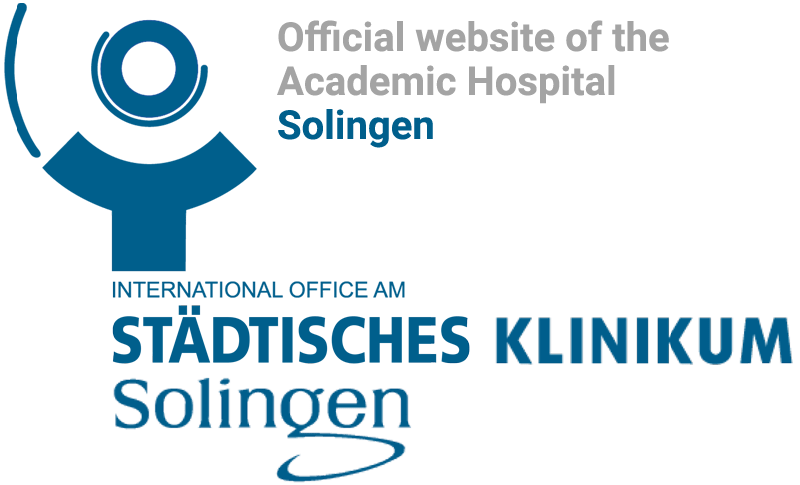Спектр услуг
Диагностика
Department U2:
- Computer tomography (CT): GE Lightspeed 64 CT multisubmarine spiral CT
- Magnetic resonance imaging (MRI): Philips Intera 1.5 Tesla
Department U1:
- Computed tomography (CT): GE Optimum 540 (16-slice CT)
- Mammography: Mammomat 3000 Siemens with stereotactic additional equipment for punctures
- Angiography: DSA digital system
- Ultrasound examination (including Duplex sonography and Doppler ultrasound examination)
Radiography:
- Diagnostics without contrast agent (for example, lungs, abdominal cavity, skeleton, dental, operational diagnostics)
- Diagnostics with contrast agent (e.g. gastrointestinal tract, phlebography, genitourinary system)
Interventional radiology
Biopsy of any organs, navigated by CT or MRI
Drainage procedures
Any intervention activities in the vascular system, such as stenting, lysis therapy, embolization, PTA (balloon expansion)
Stereotaxic breast biopsies
CT-navigated neurolisis, pain therapy
Computer Tompgraphy
Computer tomography (CT) is a method of obtaining an image of the cross section of the body using X-rays. Production of the image of the section is carried out with the help of a narrowly focused X-ray beam, which scans the desired
plane of the body from different directions.
At present, devices in which the X-ray tube and detectors are mechanically connected to each other and move along a circular path around the patient are mainly used. CT does not only provide images of the standard section of the
body, but images from different directions. Spatial representation is achieved using 3D computer tomography (3D-CT).
Typical applications include, but are not limited to, diseases:
- Heads (e.g. diagnosis of cerebral stroke and bleeding, detection of tumors and metastasis)
- Thoracic cells (chest cavity), for example, pulmonary and vascular processes, enlarged lymph nodes
- Abdomen (abdominal cavity), such as internal organ diseases, enlarged lymph nodes, tumors, vascular processes)
- Determination of mineral salinity in bone tissue (suspected osteoporosis)
- Planning of radiation therapy
Magnetic Resonance Imaging (MRI)
MRI allows you to obtain images of various areas of the body without X-ray irradiation, using a strong magnetic field and radio waves. Currently, MRI is the most modern and at the same time technically the most sophisticated way of visualization in radiology. Requirements for the quality of such examinations, respectively, are very high.
Typical applications include, but are not limited to, diseases:
- Skulls (e.g. inflammatory processes, tumors)
- Spine (e.g. a herniated disc)
- Bones and joints (e.g. meniscus and ligament injuries)
- Thoracic cavity (for example, with unclear results of X-ray mammography or ultrasound examination of the thoracic cavity with scars after surgery performed)
- Heart and blood vessels (for example, heart defects, diseases of the pelvic organs, legs, vessels of the head and neck)
- Abdomen (liver, MR-cholangiography, virtual endoscopy)
Sonography
Ultrasonic waves are mechanical fluctuations of high frequency. Their frequencies are in the treatment and diagnostic range between 1 MHz and 20 MHz. The diagnosis of ultrasound examination is based on the laws of reflection and scattering
of ultrasonic waves on the boundary surfaces with different tissue structures. As a result, the size, shape and position of the organ can be presented.
Doppler ultrasound examination (also duplex sonography) and color Doppler ultrasound examination can display changes in the vessel walls, stenosis (level of constriction), and blood flow velocity.
Areas of use
It is hardly possible to name the area of the body, which cannot be imagined with the help of ultrasound examination. The first meeting with ultrasound waves takes place in the
womb of the mother, where the unborn child is “supervised and observed”.
Some of the areas where ultrasound is used in the examination of children or adults include:
- Evaluation of processes in the abdominal cavity (e.g. kidney and gallstones, appendicitis)
- Control of the course of recovery after surgery, radiation and chemotherapy
- Swelling of soft tissues (for example, with enlarged lymph nodes, tumors or pus)
- Assessment of vessels (vascular disease, thrombosis)
Mammography
According to the generally accepted opinion, today mammography remains the main method of examination for early detection of breast cancer. It is used in several countries as a screening method for early recognition of breast cancer. This is especially important at such stages, when the tumor can still be removed while preserving the breast. In this context, another area of application is the marking of suspicious foci before surgery to narrow the area of surgery, and radiography to determine if all suspicious foci were detected.
When is the mammogram shown?
As part of a screening, the mammographic examination is recommended at intervals of 1 year beginning at the age of 40 years. The exception is women who have a high risk of breast cancer because of family history (for example, breast
and/or ovarian cancer in the family). Mammography is also indicated in post-operative dispensary monitoring of breast cancer recovery. In these cases, the optimal examination time is determined individually.
The best time for examination is the second week of the cycle, provided that the hormones have not been applied. Pregnancy should be excluded.











